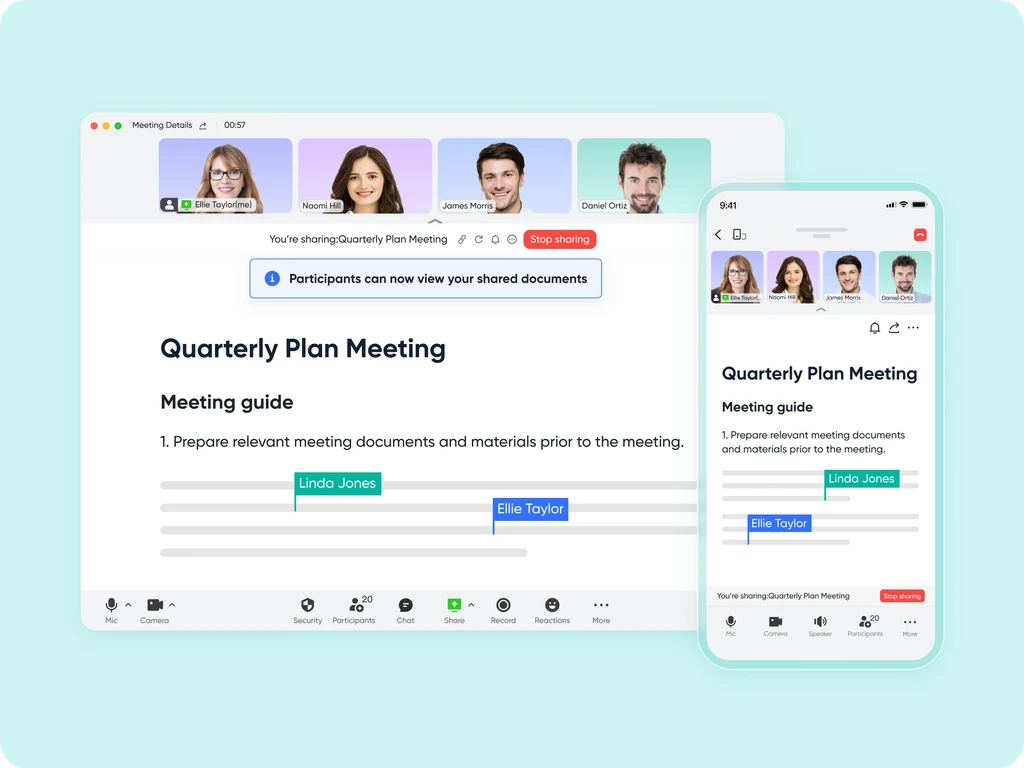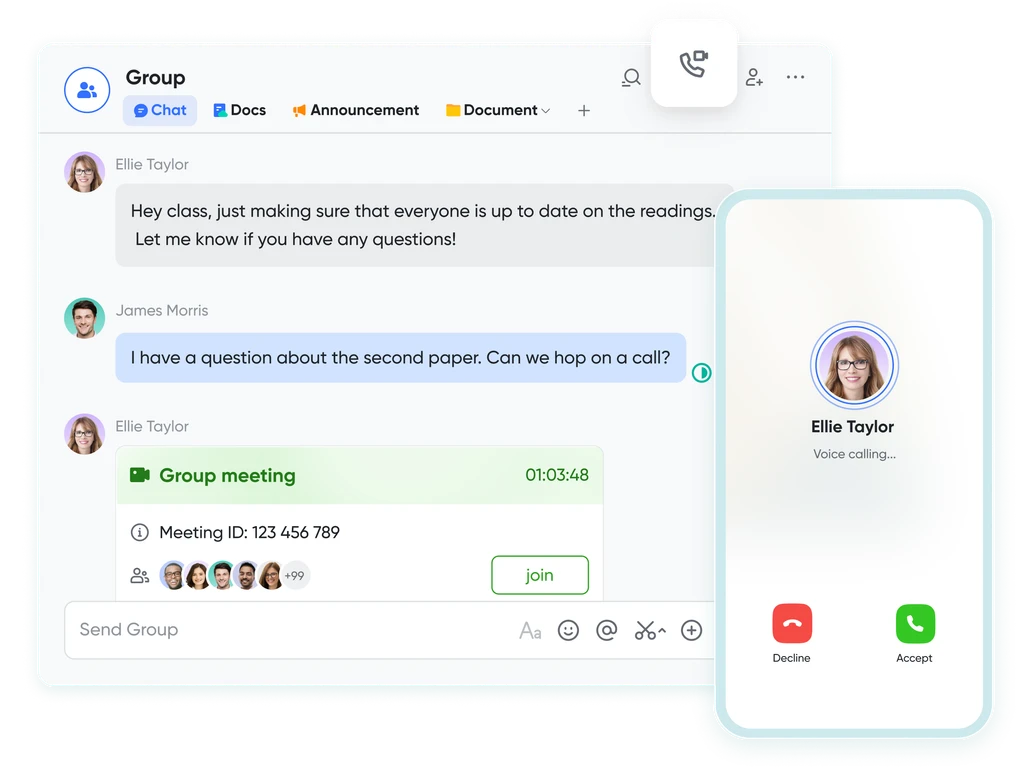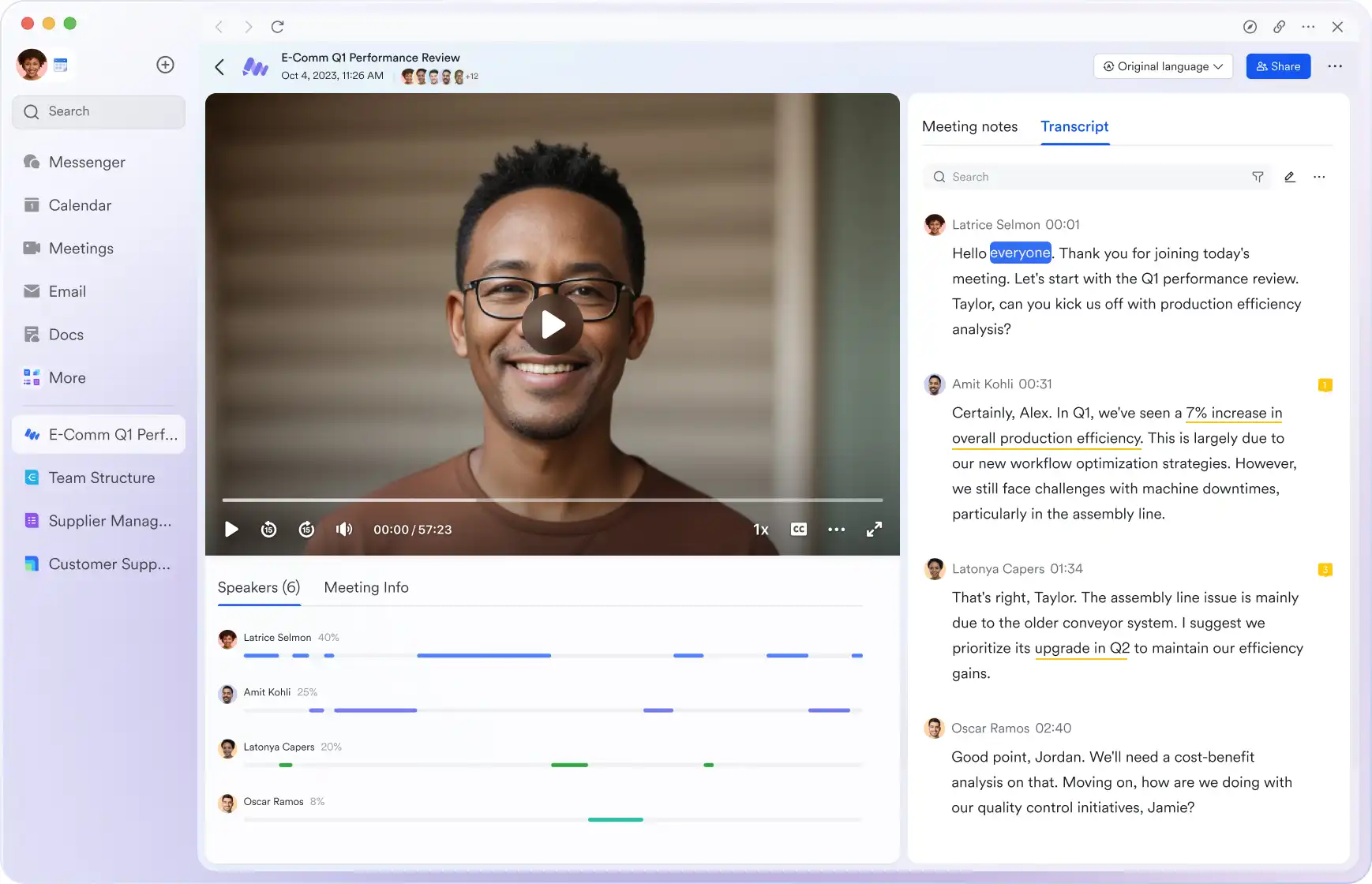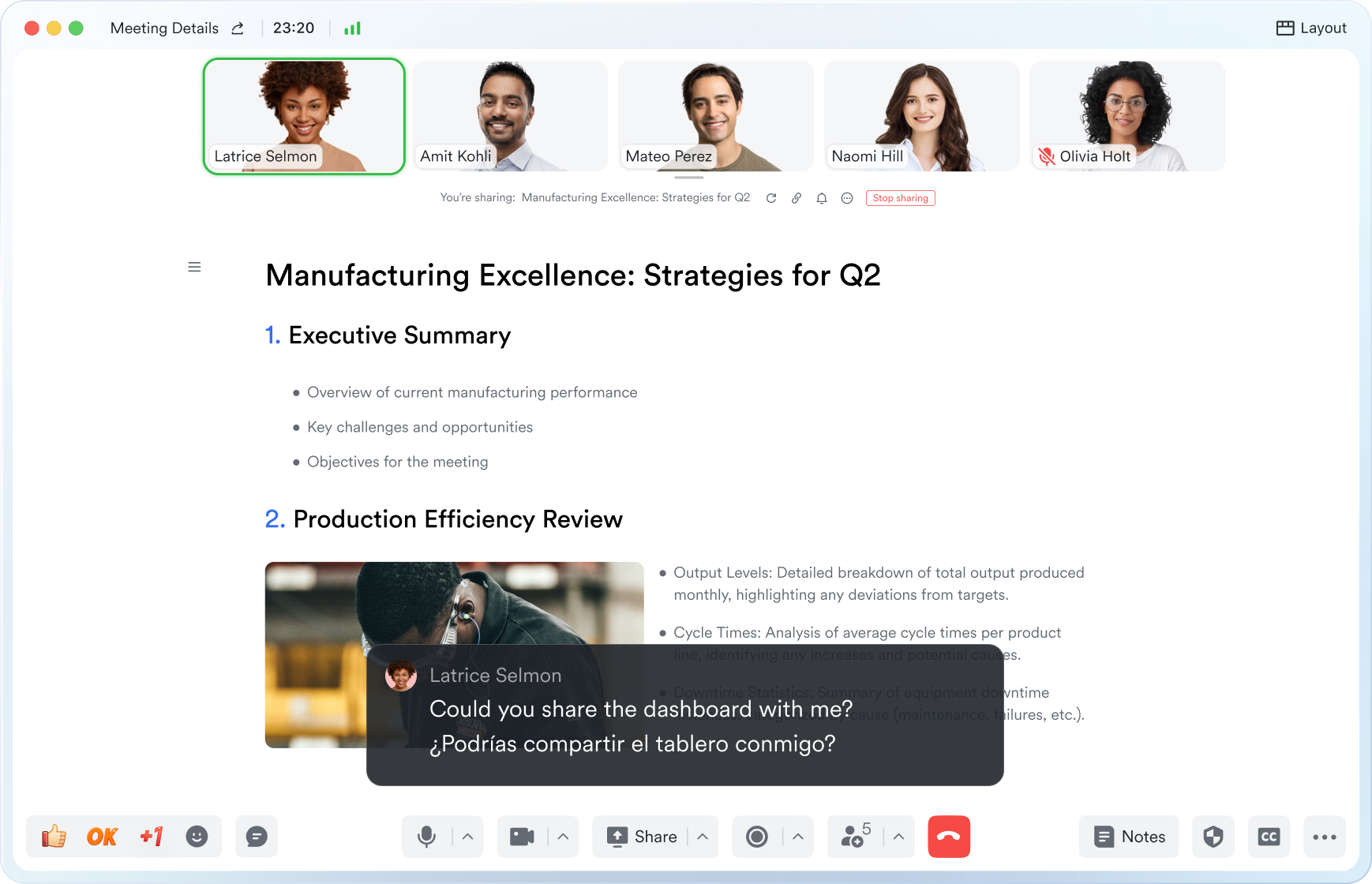Strategy Review Meeting
This guide will walk you through the essential elements of use strategy review meeting to keep your attendees aligned and engaged.
Try Lark for Free
Strategy review meetings are pivotal gatherings where organizations and teams assess their current strategies, goals, and performance to ensure alignment with their long-term vision. These meetings provide a platform for evaluating progress, making data-driven decisions, and refining strategies for success. In this comprehensive guide, we'll delve into the significance of strategy review meetings, how to conduct them effectively, and best practices for shaping the path to success.
Use Lark Meetings to turn meetings into true collaborative experiences.
What is a strategy review meeting?
Aligning Vision with Action
A strategy review meeting is a scheduled gathering where individuals, teams, or leadership groups come together to review, assess, and adapt their strategies and objectives. These meetings play a critical role in ensuring that the organization's actions align with its long-term goals and vision.
Goals of strategy review meetings
Alignment and Adaptation
The primary goals of strategy review meetings include:
- Assessment: Evaluating the progress and effectiveness of current strategies and initiatives.
- Data-Driven Decision-Making: Utilizing data and insights to inform strategic adjustments.
- Alignment: Ensuring that strategies and actions remain in line with the organization's mission and vision.
- Continuous Improvement: Identifying areas for enhancement and refinement in existing strategies.
- Communication: Facilitating open and transparent communication among stakeholders.
Who should attend strategy review meetings?
Comprehensive Participation
Strategy review meetings typically involve a diverse group of participants, including:
- Leadership Teams: Executives, managers, or department heads responsible for overseeing strategy execution.
- Strategic Teams: Teams or individuals responsible for developing and implementing specific strategies.
- Stakeholders: Individuals with a vested interest in the organization's success.
Related:
Master the Art of Meeting Notes with Lark for Enhanced Collaboration | Lark Blog | Lark BlogLearn more about Lark x Meetings
Topics and agenda for strategy review meetings
Comprehensive Assessment
An effective strategy review meeting follows a structured agenda that covers essential aspects of the organization's strategies. Here are key topics to include:
- Welcome and Introduction: Begin with introductions and a brief overview of the meeting's purpose.
- Strategic Goals and Objectives: Provide context by summarizing the organization's long-term vision and goals.
- Progress Assessment: Review progress on key strategic initiatives, projects, or milestones.
- Data and Analytics: Analyze relevant data and metrics to assess strategy effectiveness.
- Challenges and Opportunities: Discuss challenges, obstacles, or emerging opportunities that may impact strategy execution.
- Strategic Adjustments: Explore potential adjustments or refinements to existing strategies based on data and insights.
- Resource Allocation: Review resource allocation and budgetary considerations in support of strategic goals.
- Action Items: Define action items and responsibilities for implementing strategic adjustments.
- Next Steps: Outline the next steps and strategies for moving forward with refined objectives.
- Closure and Appreciation: Conclude the meeting with gratitude for participants' contributions.
How to conduct an effective strategy review meeting?
Data-Driven Decision-Making
Conducting an effective strategy review meeting requires meticulous planning, data analysis, and engagement. Here's a step-by-step guide to ensure a productive discussion:
- Preparation: Define the meeting's objectives, create an agenda, and invite relevant participants.
- Data Collection: Gather and analyze data and metrics relevant to the organization's strategies.
- Agenda Distribution: Share the meeting agenda in advance to allow participants to prepare and contribute effectively.
- Meeting Facilitation: Appoint a skilled facilitator or moderator to guide the meeting, maintain focus, and manage time.
- Progress Assessment: Begin with a review of the organization's progress toward strategic goals and objectives.
- Data-Driven Insights: Present data and analytics to inform strategic discussions and decisions.
- Challenges and Opportunities: Encourage open discussion about challenges, obstacles, or emerging opportunities.
- Strategic Adjustments: Collaboratively explore potential adjustments or refinements to existing strategies.
- Resource Allocation: Discuss resource allocation and budgetary considerations in support of strategic goals.
- Action Item Assignment: Define clear action items, assign responsibilities, and set timelines for implementing strategic adjustments.
- Next Steps: Outline the next steps and strategies for moving forward with refined objectives.
- Closure and Appreciation: Conclude the meeting with gratitude for participants' valuable insights and contributions.
Learn more about Lark x Meetings
Examples of strategy review meetings
Real-world scenarios
Real-world scenarios
Let's explore three real-world scenarios of effective strategy review meetings in different contexts:
Scenario 1: Annual Organizational Strategy Review
Brief Content: An organization's leadership team conducts an annual strategy review to assess progress on its five-year strategic plan.
Detailed Content: The strategy review meeting begins with an overview of the organization's long-term vision and strategic objectives. Leaders present progress reports on key initiatives and projects, emphasizing achievements and challenges. Data on financial performance, market trends, and customer feedback are analyzed. Participants engage in a collaborative discussion about potential refinements to the strategic plan, including adjusting goals and resource allocation. Action items are defined, including revising the annual budget to align with the refined strategy. The meeting concludes with a renewed commitment to achieving the organization's vision.
Scenario 2: Project-Specific Strategy Review
Brief Content: A project team conducts a strategy review meeting to assess progress on a complex research and development project.
Detailed Content: The strategy review meeting begins with a project overview, including its goals, scope, and timeline. Team members present progress updates on research findings, prototype development, and testing phases. Data related to project milestones and budgetary performance are discussed. Challenges, such as technical obstacles, are openly addressed. The team collaboratively explores potential adjustments to the project plan, including reallocating resources and revising research methodologies. Action items are defined, including securing additional funding for extended research. The meeting concludes with a sense of optimism and a commitment to project success.
Scenario 3: Quarterly Marketing Strategy Review
Brief Content: A marketing team conducts a quarterly strategy review to evaluate the effectiveness of its marketing campaigns and initiatives.
Detailed Content: The strategy review meeting begins with an overview of the marketing team's quarterly objectives and KPIs. Team members present data on campaign performance, including website traffic, conversion rates, and social media engagement. Challenges, such as unexpected market shifts, are openly discussed. The team engages in a collaborative discussion about potential adjustments to marketing strategies, including reallocating ad spend and targeting different audience segments. Action items are defined, including launching new ad campaigns and optimizing website content. The meeting concludes with a commitment to achieving quarterly marketing goals.
Tips for do's and don'ts
Best Practices and Pitfalls to Avoid
To ensure productive and effective strategy review meetings, follow these do's and don'ts:
| Do's | Don'ts |
|---|---|
| Define clear meeting objectives and communicate them to participants. | Don't overlook the importance of data and analytics in decision-making. |
| Gather and present relevant data and metrics to inform discussions. | Avoid making decisions without data-driven insights. |
| Foster open and collaborative discussions about challenges and opportunities. | Don't limit the discussion to successes; address challenges and concerns openly. |
| Encourage diverse perspectives and input from participants. | Avoid a one-sided or top-down approach to decision-making. |
| Define clear action items, responsibilities, and timelines for strategic adjustments. | Don't neglect to follow up on action items and track progress. |
Use Lark Meetings to turn meetings into true collaborative experiences.
A Game Changer for Strategy Review Meeting: Empower your team with Lark Meetings
In the fast-paced and dynamic world of modern business, effective communication and collaboration are crucial for success of Strategy Review Meeting. Here we introduce Lark Meetings to serve as a centralized hub for all communication needs.
Transform your meetings into collaborative endeavors

Leverage the potency of in-call document sharing, intelligent meeting minutes, and mobile-optimized features to enhance productivity collaboratively, irrespective of your location or schedule.
Seamlessly collaborate in real-time, across any device

Share live documents instead of just screen views. Participants can navigate and edit simultaneously within the video call window, even while on the move.
Shift your focus to engagement, not note-taking

Lark Minutes automatically converts video meetings into transcripts, facilitating easy viewing, searching, and collaborative editing. Stay in the loop asynchronously, even if you can't attend the live meeting. Lark Minutes for meeting minutes support translation into 10+ different languages.
Break language barriers in communication

Lark Meetings provide real-time translation for subtitles, allowing individuals from diverse backgrounds to express themselves in their native languages. Ensure every voice is heard, regardless of geographical location. Live subtitles currently support translations from English, Chinese, and Japanese to 10+ different languages. See more translation feature in Lark.
Connect with larger audiences
Host dynamic online meetings and events accommodating up to 1,000 participants, with the flexibility of up to 50 breakout sessions for intimate group discussions within the larger meeting context. Try more Lark features for free.








